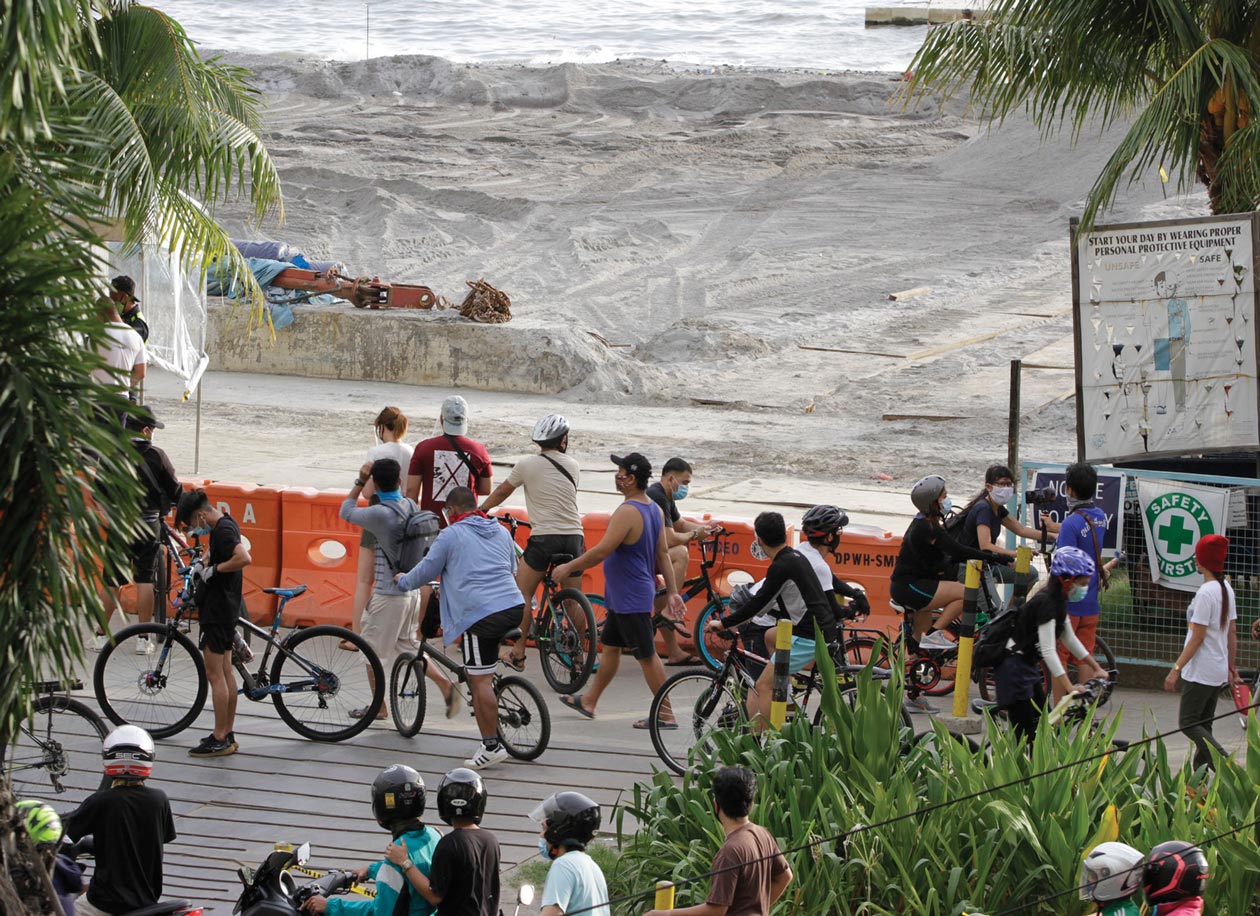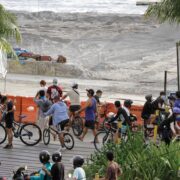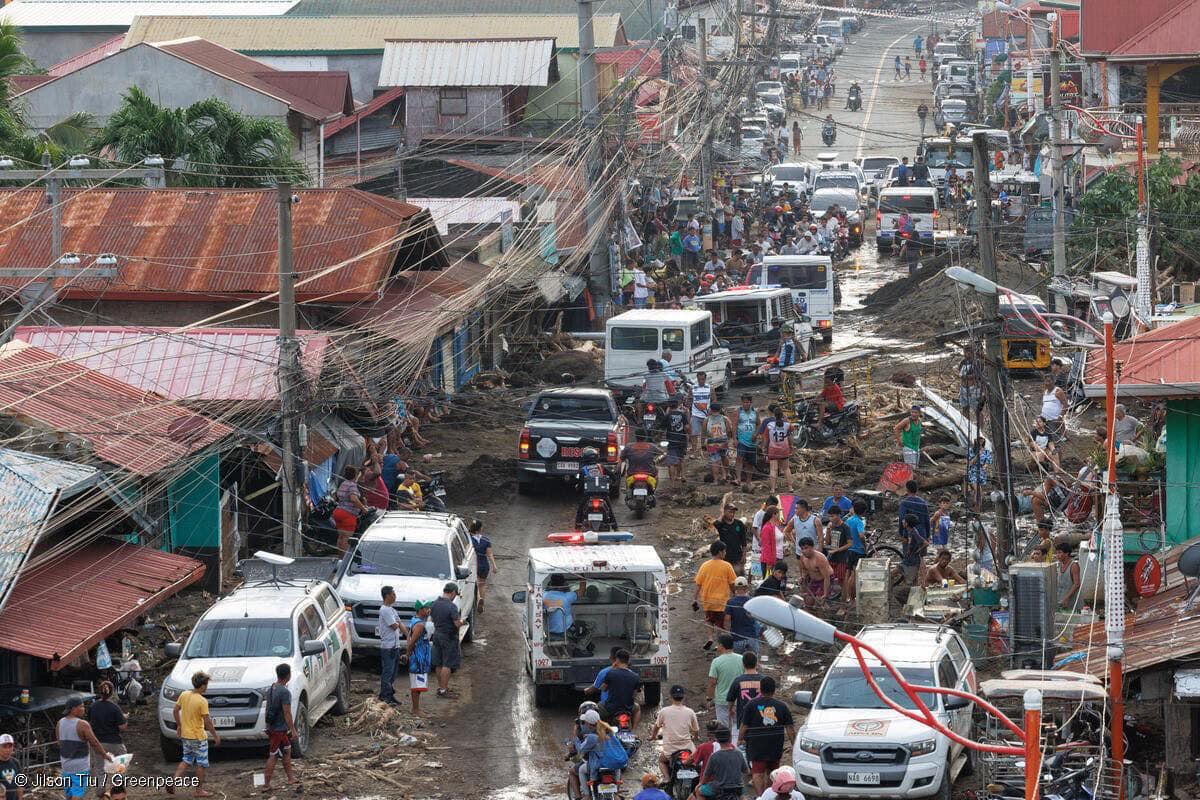
| PNA photo by Avito C. Dalan
THE Philippine Department of Environment and Natural Resources (DENR) maintained that the dolomites used to beautify the stretch of Manila Bay’s shore are safe following claims of its potential health hazard.
“It is not listed by the Mines Safety and Health Association, Occupational Safety and Health Association or even in the International Agency for Research Of Cancer as a carcinogen,” Environment Secretary Roy Cimatu said on Tuesday, September 8, during the budget deliberation of the agency before the House committee on appropriations.
Cimatu explained that the hazardous ones are the dolomite dust particles with the size of 10 to 15 microns.
He then pointed out that the size of the dolomites being used in Manila Bay is 2,000 to 5,000 microns or 100 times bigger than dust.
“Therefore, [they are] not suspended in air and it cannot be inhaled,” he said.
The DENR confirmed last September that piles of crushed dolomite were being poured on the stretch of Manila Bay”s shore to act as white sand and beautify the area.
The makeover project, which will fill 500 meters of the Manila Bywalk with white sand, is covered under the P389-million Manila Bay rehabilitation program launched by Cimatu in January last year.
However, several government officials as well as environmental groups opposed the implementation of the project.
Health hazard
According to the Department of Health, dolomite dust — made of calcium magnesium carbonate — can cause respiratory issues when inhaled.
“‘Yung dolomite dust, it can cause respiratory issues or effects to a person. Kapag napunta sa mata, nagkakaroon ng irritation so you just have to wash it off with water (If it comes in contact with the eyes, it can cause irritation so you just have to wash it off with water),” Health Undersecretary Maria Rosario Vergeire said on Monday, September 7.
“Kapag na-ingest ito, it can have discomfort sa gastrointestinal system natin and magkakaroon lang ng kaunting sakit ng tiyan at pagtatae (If this is ingested, it can have discomfort in a person’s gastrointestinal system, causing pain and diarrhea),” she added.
For her part, Senator Nancy Binay called for the suspension of the project, insisting that it was not properly researched.
“Placing dolomite as a substitute for white sand only means the project did not go through proper processes and studies for the Manila Bay rehabilitation,” Binay said in Filipino.
“There was no public consultation, no environmental clearance, and it was clear that the plan was not comprehensive and was done hastily,” the senator added.
Binay also pointed out that the DENR should’ve prioritized Manila Bay’s water quality instead of its appearance.
“In the right order of things, DENR should have prioritized fixing the water quality of Manila Bay before the aesthetics. It is just saddening that instead of first addressing the sewage system in Baseco, it prioritized the funding of white sand from Cebu,” she said.
Rodne Galicha, executive director of environmental group Living Laudato Si Philippines, echoed this sentiment, stressing that Manila Bay’s water pollution should be addressed first.
“The root cause of the problem is pollution. If the root cause of the problem is pollution and you just put bandaid or makeup there, it will not solve the problem, Manila Bay will not be rehabilitated,” he said.
Writ of kalikasan
University of the Philippines (UP) law professor Jay Batongbacal noted that it is possible to secure a writ of kalikasan and injunction against the project due to its potential health hazard.
The writ of kalikasan is a remedy for unlawful actions violating the right to a balanced and healthful ecology.
“This is why any agency should have conducted a thorough assessment of a project first,” Batongbacal said.
“The DENR definitely violated several laws. Even something as basic as a consultation with the local government[s] was not done,” he added.
Advocacy group Oceana Philippines, meanwhile, also said the DENR violated laws governing ecological and heritage conservation.
It claimed that the agency failed to comply with the mandatory environmental impact assessment study required under Presidential Decree No. 1586 and the Philippine Fisheries Code of 1998 — both of which require a thorough assessment of possible effects of any project deemed to have an adverse impact on the environment and surrounding communities.
Oceana also said the Wildlife Conservation Act was violated by the DENR for mining dolomite boulders from Cebu.
“Cebu is even one of the 10 provinces considered to be [landslide-prone areas],” Oceana Vice President Gloria Estenzo-Ramos said.
“This is why the [environmental impact assessment] is necessary for both [Manila and Cebu],” she added.
Ramos confirmed that several environmental groups are going to meet and discuss filing a petition for a writ of kalikasan against the white sand project.
“It’s always an option under the rules of procedure for environmental cases, even a threat to destruction…It is a ground for applying a writ of kalikasan,” she said.
“Environmental groups will meet and discuss what will be the next steps, what actions will be taken,” she added.
Robredo: P300-M budget could have fed families amid pandemic
Vice President Leni Robredo, for her part, slammed the project, calling the agency’s move “insensitive” for focusing on beautifying the area while the country is fighting against novel coronavirus pandemic.
“It’s really insensitive for you to do it at the height of the pandemic when so many people are starving. A lot of people are struggling, but what you’re doing is to beautify,” Robredo said in Filipino during her weekly radio show.
The vice president also noted that the project for the white sand project could have gone to the poorest households affected by the global health crisis instead.
“How difficult is it to reassess the budget?…Why did they prioritize this?” Robredo said.
Likewise, Sen. Francis “Kiko” Pangilinan said that the government should be putting Filipinos affected by the pandemic first before the beautifying project.
“It is completely unacceptable that while our people are going hungry, parents have lost their jobs, and children have no gadgets to use for online classes, we are wasting money for a project that can only contribute to the destruction of our environment and our health,” he said.
According to the senator, the project’s budget could have been used to procure sacks of rice as well as provide students with internet connection and laptops.
“The last thing we want in the middle of this pandemic is causing more risks to the health and safety of our people,” Pangilinan stressed.
“Our healthcare system is already overwhelmed due to COVID-19 and the corruption in PhilHealth and we’ll just be adding more problem to that,” he added.
DENR: Funds for Manila Bay white sand can’t be used for pandemic
The DENR, in response, said the budget for Manila Bay’s makeover can’t be diverted to projects addressing the pandemic.
According to DENR Undersecretary Benny Antiporda, the project was bankrolled and bid out more than a year ago.
“This is not a new project. We cannot connect this with the pandemic,” he told ANC.
“If this were money that we can juggle from one place to another, the government would do that. But that is not possible. That is prohibited,” he added.
Presidential Spokesperson Harry Roque backed the DENR, saying that the project was planned before the pandemic.
“The budget for the project is included in the 2020 national budget. It was approved in 2019. We did not expect to encounter the COVID-19 pandemic. Budget rules also state that if it is a line item, the money can only be spent for that specific purpose,” he said in Filipino.
“The project was not planned amid the pandemic. The budget was approved in 2019,”he added.
Earlier, Roque expressed support for the white sand project.
“I was born at the Philippine General Hospital and as a Manila resident, I am glad that there is a Manila Bay beautification project. The people of Manila also need access to a beautiful beach especially now that there are travel restrictions,” he said.
“I am glad that there is a new attraction in the City of Manila,” the Palace official added.







The root cause of the pollution problem is the value of people like throwing of garbage anywhere. NGOs and politicians like Sen. Binay, criticizing the goodness of the white sand project in Manila Bay, should make more contribution to change the values of people, even their own values. I know they understand that beach nourishment is just a component of the overall rehabilitation project of Manila Bay but they are washing it black, tainting it with bias reporting whose only motive is to destroy the image of the Filipino. I pity the restless soul of these people.